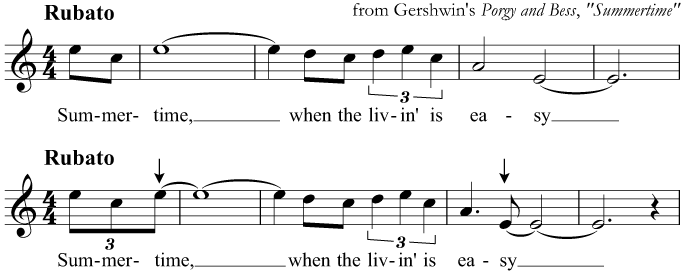Syncopation
In this guide...
Key terms:
Subscription required!
To view the complete study guide, you will need a valid subscription. Why not subscribe now?
Already have a subscription? Make sure you login first!
Introduction
You may have heard the term "syncopation" or "off-beat" to refer to rhythmically exciting music. Let's have a look at what those terms mean, and how we might use syncopation in composition.
Beats
Do you remember that some beats in a time signature are stronger than others?
In 2/4 this is a simple "strong-weak" alternation, in 3/4 it is a little more complex: "strong-weak-weak"; and in 4/4 we even have three levels: "strong-weak-medium-weak".
 A reminder of strong and weak beats
A reminder of strong and weak beatsOff-beats
An off-beat is another term for a "weak" beat in a time signature, such as the second beat in 2/4, or the second and fourth beats in 4/4.
Where we only have two beats to consider, we can also call the strong beat the down beat, and the weak beat the up-beat. We will look at upbeats further in Upbeats.
Syncopation
The normal situation, therefore, is to expect an emphasis on the "strong" beat. However, interesting music is music that plays tricks with our expectations!
Music which gives emphasis to the weak beats of a time signature instead of the strong beats is described as "off-beat", or more commonly, "syncopated" music, and the technique of emphasising the weak beats instead of the strong beats is called syncopation.
 A simple example of syncopation on the 2nd and 4th beats, indicated
A simple example of syncopation on the 2nd and 4th beats, indicatedThis is a very effective technique to use in composition to make rhythm come alive! It can be found in much jazz music and many folk traditions as well as frequently in classical music.
For instance, see the example from Beethoven below:
 Syncopation in Beethoven's Piano Sonata no. 31
Syncopation in Beethoven's Piano Sonata no. 31Notice how the phrase starts and ends with normal first-beat accents but that in the middle, the left hand accents the second beat of each bar instead of the first. Beethoven even marks dynamic accents sfz on these off-beat notes, to make sure we understand that we should heavily emphasis the "wrong" beats.
More examples
Music can give emphasis to strong and weak beats in a huge variety of different ways.
Syncopation refers to a relative emphasis on the weak beats, and this can be a strong or weak emphasis.
Consider the bars of rhythms shown below, and imagine that they repeat over and over - try clapping them. In the first bar, notes appear only on the weak second and fourth beats of 4/4, and clearly this is an example of syncopation:
 A clear example of syncopation
A clear example of syncopationThe next example is similar, except that there is a note on the first beat too. This emphasis on a strong beat makes the bar as a whole less syncopated:
 An example with weaker syncopation
An example with weaker syncopationIn the third example, there are notes at beats one and four. It would be inappropriate to call this a syncopated rhythm because any suggestion of emphasis on beat four is undone by the strong beat one which follows immediately.
 An rhythm without syncopation
An rhythm without syncopationOver the barline
The strongest and most effective syncopation, then, is when the weakest beat is heard and the strongest beat is not. This is quite simple to achieve, by simply tying an "up-beat" to the following "down-beat", for example over a barline as shown in the Beethoven above.
In fact, in a lot of jazz music in particular, the 1st beat is "anticipated" in this way, which causes an almost physical reaction in listener as the 1st beat is only felt and not heard. Listen out for this next time you hear some jazz!
Here is an example of how a piece of music that is notated "straight" might be played in a jazz style, by turning a non-syncopated rhythm into a syncopated one:
 Anticipating the beat in Gershwin's Summertime, notated "straight" (top) and as played syncopated (bottom)
Anticipating the beat in Gershwin's Summertime, notated "straight" (top) and as played syncopated (bottom)Read more...
With a subscription to Clements Theory you'll be able to read this and dozens of other study guides, along with thousands of practice questions and more! Why not subscribe now?
Revision
Are you sure you've understood everything in this study guide? Why not try the following practice questions, just to be sure!